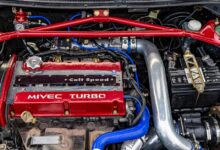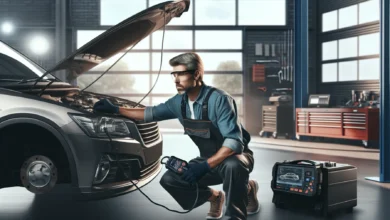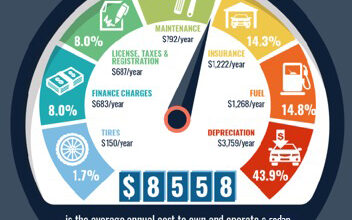Engine Spark Plugs: Complete Guide to Replacement, Types, Maintenance & Troubleshooting
Sponsored Ads
When I think about what keeps my car running smoothly day after day, spark plugs always come to mind. These small yet mighty components play a crucial role in powering the engine and ensuring everything runs smoothly. Without reliable spark plugs, even the most powerful engine can stumble or refuse to start altogether.
I’ve learned that selecting the correct spark plugs and knowing when to replace them can make a significant difference in performance and fuel efficiency. Whether you’re a seasoned DIY enthusiast or just starting to explore what’s under the hood, understanding spark plugs is crucial to keeping your engine at its best.
Understanding How Engine Spark Plugs Work
Engine spark plugs create the necessary spark to ignite the air-fuel mixture. Consistent ignition ensures that every combustion cycle in the engine occurs at the intended time and temperature.
The Role Of Spark Plugs In Engines
Engine spark plugs ignite the compressed air-fuel mixture, powering the vehicle. Each spark plug uses high-voltage electricity from the ignition coil to generate a spark across a precise gap. Reliable firing of the plug ensures complete combustion, which drives pistons and delivers optimal power output. Accurate operation of the spark plugs reduces engine misfires, minimizes emissions, and improves overall fuel efficiency.
Types Of Engine Spark Plugs
Several types of engine spark plugs, including copper, platinum, and iridium, serve different vehicle or performance needs.
- Copper spark plugs provide excellent conductivity and fit most older engines with lower voltage ignition systems.
- Platinum spark plugs feature a platinum disc on the center electrode, which increases durability and maintains gaps more effectively.
- Iridium spark plugs utilize a fine iridium tip to extend lifespan and produce the most consistent sparks, which are ideal for high-performance or modern engines.
Selection of material and design directly affects efficiency, longevity, and combustion quality in automotive engines.
Materials And Tools Needed
I use specific tools and spark plugs to achieve precise engine spark plug removal and installation. Selecting the correct materials prevents misfires and extends engine performance.
Tools For Removing And Installing Spark Plugs
I gather the following tools before changing engine spark plugs for accuracy and safety:
- Ratchet and spark plug socket for secure grip and unplugging; most sockets include a rubber insert to protect the plug ceramics
- Socket extension bar for reaching deeply recessed engine spark plugs in compact engine bays
- Torque wrench for achieving proper tightness, which prevents both overtightening and leaks
- Spark plug gap gauge for measuring and adjusting the electrode gap to match engine specifications
- Compressed air canister for blowing away dirt or debris before plug removal; this step avoids contamination in the engine
- Dielectric grease and anti-seize compound for improved terminal contact and prevention of thread galling or corrosion
Recommended Replacement Spark Plugs
I match spark plugs to vehicle recommendations and engine specifications to ensure optimal combustion:
| Spark Plug Type | Material | Lifespan (miles) | Example Application |
|---|---|---|---|
| Copper Core | Copper | 20,000–40,000 | Older engines, high-compression |
| Platinum | Platinum | 60,000–100,000 | Modern sedans, standard commuting |
| Iridium | Iridium | 100,000+ | Performance, high-efficiency |
I reference the vehicle’s owner’s manual or manufacturer’s database before installing new engine spark plugs, as heat range and thread design significantly affect engine compatibility. Always use OEM-specified plugs for direct replacement to prevent engine knock and misfires.
Preparing To Replace Engine Spark Plugs
Preparations for replacing engine spark plugs directly affect the ease and quality of the installation process. Taking proper steps promotes safety, prevents damage, and ensures consistent engine spark plug performance.
Safety Precautions
Observing safety precautions before replacing engine spark plugs eliminates hazards during the procedure. I turn off the engine and allow it to cool for at least 30 minutes because hot components increase the risk of burns. I disconnect the negative terminal of the battery to prevent electric shocks and inadvertent engine starts, following commonly cited recommendations from automotive safety guides, such as the National Highway Traffic Safety Administration (NHTSA). I wear protective gloves and safety glasses when handling engine spark plugs, as metallic debris or sharp edges can cause injuries.
Locating The Spark Plugs
Locating the spark plugs on an engine ensures efficient removal and installation. I consult the engine layout diagram for my specific vehicle, often available in the owner’s manual or official manufacturer resources. On most inline and V-type engines, I find spark plugs along the cylinder head—four spark plugs for four-cylinder engines, six for six-cylinder engines, and so on. Many modern engines conceal spark plugs under ignition coils or plastic engine covers, requiring the removal of those components first.
Cleaning Around The Spark Plug Area
Cleaning around the spark plug area before removal prevents dirt from entering the combustion chamber. I use a can of compressed air or a soft-bristled brush to eliminate debris surrounding each engine spark plug. Removing dirt in this way prevents contamination and ensures a clean environment for installation, which supports optimal combustion and engine longevity.
How To Remove Old Engine Spark Plugs
Removing old engine spark plugs allows for a direct improvement in ignition performance and prevents misfires caused by worn components. Using precise steps and techniques minimizes the risk of damage during the removal process.
Step-By-Step Removal Process
- Prepare Work Area
I remove debris around the spark plug wells using compressed air or a soft brush before touching the plugs. Complete engine cooling ensures that metal parts contract, reducing the risk of seizure.
- Disconnect Spark Plug Wires Or Coils
I gently twist and pull each spark plug wire or coil, using only enough force to prevent damage to the wire or connector. Marking wires by cylinder order eliminates confusion during installation.
- Attach Spark Plug Socket
I connect a spark plug socket and extension to the ratchet, fitting it securely over the plug for maximum stability, especially in deep plug wells.
- Loosen And Remove Spark Plug
I turn the ratchet counterclockwise in short, controlled motions, gradually loosening the plug. Removing the spark plug slowly reduces thread or porcelain breakage.
- Inspect Old Spark Plug
I inspect the removed spark plug for deposits, oil, or damage to diagnose engine conditions or confirm replacement timing.
Tips For Stubborn Or Stuck Spark Plugs
- Apply Penetrating Oil
I spray penetrating oil (e.g., PB Blaster) around the spark plug base, waiting 10-15 minutes for the oil to seep and loosen the corrosion, particularly for plugs showing high resistance.
- Use Steady Pressure
I apply smooth, straight torque using a quality spark plug socket to prevent breaking the plug or damaging its threads when it resists movement.
- Heat Engine Briefly, If Needed
I run the engine for 2-3 minutes, then shut it off and attempt removal while the cylinder head is mildly warm, if the plug remains seized after cooling and oil application.
- Double-Check Socket Alignment
I ensure the socket seats fully on the plug, preventing slippage or breakage. Misalignment increases the risk of breakage on tight or corroded plugs.
- Avoid Excessive Force
I use hand tools only, not impact wrenches or power tools, to avoid snapping the ceramic or stripping threads, especially on older plugs.
Engaging each step in sequence and following these best practices improves the spark plug removal process and engine longevity.
Installing New Engine Spark Plugs
Installing new engine spark plugs directly improves combustion quality and driving response. Precision in each step enhances engine performance and longevity.
Checking The Gap On New Spark Plugs
Checking the gap on the new spark plugs confirms they match the manufacturer’s specifications. I use a spark plug gap gauge to measure the distance between the center and ground electrode. Adjusting is necessary only if the gap falls outside the listed value in my owner’s manual or under the hood. Copper, platinum, and iridium spark plugs often arrive pre-gapped; however, verification is necessary to prevent ignition issues.
Applying Anti-Seize And Dielectric Grease
Applying anti-seize to spark plug threads assists with future removal, provided my vehicle manufacturer recommends it. I apply a small amount only to the threads, making sure none of it contacts the electrodes. Using dielectric grease on the inside of the spark plug boot stops moisture entry and reduces the risk of arcing, especially in high-humidity climates or turbocharged engines.
Properly Installing And Torqueing Spark Plugs
Properly installing and torquing spark plugs starts with hand-threading each plug into its cylinder. Cross-threading risks cylinder head damage, so I always follow the direction by hand until I feel resistance. Using a torque wrench, I tighten to the recommended specification, with values commonly between 15 ft-lbs for aluminum heads and 25 ft-lbs for cast iron, referencing my vehicle’s manual or manufacturer’s chart for exact numbers. Over-tightening can crack spark plugs or distort their threads, while under-tightening may cause gas leaks or loosen the plugs.
Reattaching Spark Plug Wires Or Coils
Reattaching spark plug wires or coils involves connecting each lead or coil to its designated spark plug, following my numbered sequence or color codes noted during removal. I listen or feel for a firm click or snap, confirming a secure connection. Skipping proper reconnection commonly results in misfires or engine hesitation. Reinforcing connections with a final inspection minimizes missed firings and ensures the ignition system operates at peak efficiency.
Post-Installation Steps
Confirming proper installation of engine spark plugs improves reliability and safeguards performance. Completing verification steps before regular driving detects potential errors.
Double-Checking Connections
Verifying all spark plug wires and ignition coil connections prevents misfiring and ensures stable ignition. I press each wire or coil boot onto its corresponding spark plug until I feel or hear a click. I inspect each cylinder for loose boots or exposed terminals. I align wire routing tabs and harness clips using vehicle-specific guides for even tension and correct organization. Testing for secure connections before proceeding reduces the chance of early engine issues.
Testing The Engine After Installation
Starting the engine after spark plug installation allows rapid identification of misfires or unusual sounds. I idle the engine for 1 to 2 minutes and monitor for steady operation or dashboard warning lights. I listen for smooth firing and uniform idle speed. I observe the exhaust for excessive smoke or the smell of unburned fuel, if present, as indicators of installation problems. I briefly accelerate in neutral to confirm responsive throttle input and check for hesitation or roughness. Performing these final checks before driving confirms the effectiveness of the engine spark plug replacement process and promotes consistent combustion.
Troubleshooting Common Engine Spark Plug Issues
Engine spark plug issues directly disrupt ignition consistency, reduce engine efficiency, and cause performance irregularities. I address the most frequent symptoms and root causes next.
Difficulty Starting The Engine
Hard starting is closely tied to worn or failing spark plugs, especially during low-temperature conditions or after extended mileage intervals. I check for excessive carbon buildup or damaged electrodes on each plug because both obstruct proper spark formation. I inspect the ignition wires or coils next for cracks or corrosion, as faulty connections can interfere with the electrical flow. If persistent, I reference the engine control module for stored diagnostic codes, as electronic miscommunication can also contribute to the issue.
Engine Misfires Or Rough Idle
Unstable idle and repeated misfires often originate from spark plugs with improper gaps, heat range mismatch, or aging insulation. I use a gap gauge to confirm that the distance matches the manufacturer’s value, as an incorrect gap can widen the misfire frequency. I examine each plug’s ceramic insulator for hairline cracks and replace plugs with visible damage. If misfiring persists after plug replacement, I verify each ignition wire or coil generates a steady voltage output, using an ohmmeter or scan tool, as intermittent current also causes irregular firing.
Spark Plug Fouling Or Deposits
Contamination and deposit buildup signal incomplete combustion or incorrect air-fuel ratios. I review spark plug color and residue type to identify underlying sources:
| Deposit Type | Likely Cause | Visual Cue |
|---|---|---|
| Black (sooty) | Rich fuel mixture, faulty sensor | Dry, powdery black coating |
| Oily | Worn piston rings, valve seal leaks | Shiny, wet oil on the electrode |
| White (chalky) | Coolant leakage, overheating, lean mix | Hard, white glaze |
I replace fouled plugs since deposits inhibit the spark. I inspect the fuel and ignition systems for leaks or sensor faults to address root causes if I discover consistent fouling across multiple plugs.
Maintenance Tips For Engine Spark Plugs
Routine spark plug maintenance improves ignition reliability and preserves consistent fuel efficiency. Regular assessment reduces the risk of misfires and ensures smooth engine operation.
Recommended Replacement Intervals
Recommended engine spark plug replacement intervals are typically listed in the vehicle owner’s manual and the manufacturer’s technical bulletins. Copper spark plugs often reach the end of their life at 20,000 to 30,000 miles. Platinum spark plugs perform reliably for up to 60000 miles. Iridium spark plugs reach optimal longevity with intervals of 80000 to 100000 miles. Adhering to manufacturer-recommended schedules strengthens engine performance and minimizes combustion inconsistencies.
| Spark Plug Type | Typical Replacement Interval (miles) |
|---|---|
| Copper | 20000–30000 |
| Platinum | 60000 |
| Iridium | 80000–100000 |
Signs Your Spark Plugs Need Attention
Signs that engine spark plugs require attention include difficulty starting the engine, noticeable engine misfires, rough idling, reduced acceleration, and lower fuel economy. Dark or oily deposits on spark plug electrodes, visible cracks in the ceramic insulator, or gaps that deviate from manufacturer specifications indicate the need for inspection or replacement. Consistently addressing these signs maintains reliable ignition cycles and extends overall engine life.
Alternative Methods And Professional Help
Exploring alternative methods or consulting a professional often improves outcomes for engine spark plug issues. The approach outlined below identifies situations where independent troubleshooting limits efficiency and where specialized products yield better results.
When To Consult A Mechanic
Contacting a certified mechanic solves advanced engine spark plug problems that basic replacement steps cannot address. Persistent misfires, check engine lights after new spark plug installation, or signs of cross-threaded spark plug threads indicate the need for expert diagnostic tools and repair techniques. I use professional help when I encounter stripped threads inside the cylinder head or when I face engine misfire codes (such as P0300 or P0301). If I detect ignition coil failure symptoms or repeated spark plug fouling after maintenance, the underlying cause—often involving fuel injectors or computer-controlled ignition systems—frequently demands advanced testing. Relying on a technician prevents additional engine damage in these situations.
Choosing High-Performance Or Specialty Spark Plugs
Selecting high-performance or specialty spark plugs improves combustion for engines with unique requirements. My turbocharged or modified engines require spark plugs with copper cores and multiple ground electrodes to manage higher temperatures and boost pressures. Performance plug types—such as double platinum or iridium-tipped spark plugs—extend service life, especially under demanding conditions. Suppose my vehicle has an LPG or CNG fuel system. In that case, I use specialty spark plugs designed for alternative fuels, as their heat ranges and electrode designs are optimized to handle these applications. Performance-focused spark plugs, offered by established brands such as NGK or Denso, feature specific gap settings and material compositions to deliver improved throttle response, stable ignition, and enhanced engine efficiency in specialized driving scenarios.
Conclusion
Taking care of your engine’s spark plugs isn’t just about keeping your car running—it’s about maximizing performance and efficiency every time you drive. I’ve found that staying proactive with spark plug maintenance saves time and money in the long run.
Whether you’re a seasoned car enthusiast or just starting to learn the basics, paying attention to your spark plugs can make a real difference. If you experience persistent issues or wish to upgrade your setup, please don’t hesitate to contact a trusted professional for guidance. Your engine will thank you for it.
Frequently Asked Questions
What do spark plugs do in a car engine?
Spark plugs ignite the air-fuel mixture in the engine’s cylinders. This spark starts combustion, powers the engine, and ensures smooth operation and improved fuel efficiency.
How often should spark plugs be replaced?
Replacement intervals depend on the type: copper plugs last 20,000–30,000 miles, platinum up to 60,000 miles, and iridium between 80,000–100,000 miles. Always check your owner’s manual for specific recommendations.
How do I know if my spark plugs need to be changed?
Common signs include difficulty starting the engine, rough idle, engine misfires, reduced fuel economy, or visible deposits and cracks on the plugs.
What tools are needed to change spark plugs?
Essential tools include a ratchet, spark plug socket, torque wrench, and a spark plug gap gauge. Optional items are anti-seize lubricant and dielectric grease.
Which type of spark plug is best for my car?
Always consult your vehicle’s owner manual or manufacturer database. Choose copper for standard use, platinum for longer life, or iridium for high performance and durability.
Can I change the spark plugs myself, or should I take it to a mechanic for the job?
Most people with basic mechanical skills can replace spark plugs effectively using the right tools and taking proper safety precautions. However, if problems persist or you’re unsure, consult a professional mechanic.
What are the signs of a bad or failing spark plug?
Look for trouble starting, engine misfires, poor acceleration, rough idling, and decreased fuel economy. Also, inspect for carbon buildup, oil deposits, or cracks.
Is it essential to check the gap on new spark plugs?
Yes. Ensuring the proper gap using a gap gauge according to the manufacturer’s specifications is crucial for optimal performance and preventing misfires.
What safety steps should I follow when replacing spark plugs?
Please turn off the engine, let it cool, disconnect the battery, and wear gloves and safety glasses to prevent injury and protect electrical components.
What should I do if a spark plug is stuck and won’t come out?
Apply penetrating oil, let it sit, and use steady pressure with a correct socket. Briefly running the engine to warm it up can also help, but avoid using excessive force to prevent damage.










